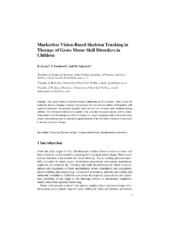Приказ основних података о документу
Markerless Vision-Based Skeleton Tracking in Therapy of Gross Motor Skill Disorders in Children
| dc.creator | Karan, Branko | |
| dc.creator | Golubović, Špela | |
| dc.creator | Gnjatović, Milan | |
| dc.date.accessioned | 2017-06-10T15:45:07Z | |
| dc.date.issued | 2014 | |
| dc.identifier.isbn | 978-3-319-05430-8 | |
| dc.identifier.uri | https://dais.sanu.ac.rs/123456789/669 | |
| dc.description.abstract | This chapter presents a research towards implementation of a computer vision system for markerless skeleton tracking in therapy of gross motor skill disorders in children suffering from mild cognitive impairment. The proposed system is based on a low-cost 3D sensor and a skeleton tracking software. The envisioned architecture is scalable in the sense that the system may be used as a stand-alone assistive tool for tracking the effects of therapy or it may be integrated with an advanced autonomous conversational agent to maintain the spatial attention of the child and to increase her motivation to undergo a long-term therapy. | en |
| dc.format | (2014) 79-93 | |
| dc.format | application/pdf | |
| dc.language | en | |
| dc.publisher | Springer International Publishing | |
| dc.relation | info:eu-repo/grantAgreement/MESTD/Integrated and Interdisciplinary Research (IIR or III)/44008/RS// | |
| dc.rights | openAccess | |
| dc.source | New Trends in Medical and Service Robots: Challenges and Solutions | en |
| dc.subject | 3D sensing | |
| dc.subject | skeleton tracking | |
| dc.subject | computer-aided therapy | |
| dc.subject | human-machine interaction | |
| dc.title | Markerless Vision-Based Skeleton Tracking in Therapy of Gross Motor Skill Disorders in Children | en |
| dc.type | bookPart | |
| dc.rights.license | ARR | |
| dcterms.abstract | Каран, Бранко; Голубовић, Шпела; Гњатовић, Милан; | |
| dc.citation.spage | 79 | |
| dc.citation.epage | 93 | |
| dc.identifier.wos | 000390825000006 | |
| dc.identifier.doi | 10.1007/978-3-319-05431-5_6 | |
| dc.identifier.scopus | 2-s2.0-84928169852 | |
| dc.type.version | publishedVersion | |
| dc.identifier.fulltext | https://dais.sanu.ac.rs/bitstream/id/21636/666.pdf | |
| dc.identifier.rcub | https://hdl.handle.net/21.15107/rcub_dais_669 |

